Last updated: March 1, 2022
Article
Girl (Guide) Power
Just as the contributions of many women have been overlooked in NPS history, so too have the contributions of girls who held officially sanctioned guide positions.
Teenage Triumph
Judy “Juju” Alexander was born in February 1934, two years after her parents Tom and Judy Alexander Sr. opened the Cataloochee Ranch, the only tourist facility on the North Carolina side of the new Great Smoky Mountains National Park. The family operated the ranch at this location for five years before NPS restrictions and the annual lease arrangement discouraged expansion of the business. They sold and moved to Pensacola, Florida.
Within a couple of years the family was back in the Smokies. They purchased land at Fie Top Mountain just outside the park to create a new ranch and resort business. The remote location meant that JuJu and her siblings spent their weekdays at boarding schools or with family off the mountain. Weekends, school holidays, and summers were spent at the ranch. Juju loved the outdoors. Her father and others taught her about forestry, horses, gardening, haying, and mountain traditions. It wasn’t long before she was leading rides and taking pack trips on the family ranch. Eventually she was put in charge of the ranch’s riding program.
In 1948, when she was just thirteen years old, Alexander became the youngest NPS licensed guide in the country. In Mountain Fever, a book largely written by her father, she recalls riding her horse Dixie and leading parties of visitors from the family ranch into the park. Due to her age, her father only let her guide day rides and “short nighters,” trips where guests were taken to predetermined campsites for overnight stays before returning to the ranch. Her story as an NPS guide was picked up in several newspapers in 1948 and 1949. One referred to her as a “teenage triumph.”
It’s unlikely that Alexander held an NPS guide license after 1949 when she was sent to Richmond, Virginia, to finish school. Following high school she earned a degree in political science from Duke University. She worked as personal secretary to Senator Kelly Bennett in the North Carolina General Assembly before marrying Richard Coker in 1957. Together they had three children. With other family members, the Cokers managed the family ranch and a ski area started by her parents in 1961. Judy Alexander Coker died in March 2019 at age 85.
Badge of Service
The Girl Scouts of the United States of America created ranger aide and museum aide programs in the 1940s. Girls aged 14 to 18 were eligible as senior scouts. The ranger aides were initially used in national forests, where they were particularly helpful during dangerous fire seasons. Girl Scout aides began working in national parks in 1950. Two years later the Girl Scouts organization authorized small, rectangular service aide bars with enameled colors to indicate different aide programs. Both museum and ranger aide bars were made beginning in 1953. Museum aide bars were red. Ranger aide bars were brown until 1974, when the color was changed to tan. The bars were worn on the uniform pocket beside the senior service emblems. The service aide bars were eliminated in 1979.
Morristown National Historical Park offered a course for Girl Scout museum aides in January 1950. Thirty-two girls applied for the first course; 25 were accepted. Arranged by park historian Melvin Weig, the course included historical information, a park tour, and a behind-the-scenes tour of the park’s museum collection. Upon completion of the course, the museum aides were expected to give three hours each weekend for three months, working as museum guides. Although there were plans to continue the program, it’s not clear how many classes there were, how many girls participated, or if the program continued after Weig left the park to become superintendent at Edison National Historic Site in 1956.
Also in 1950, troop leader Georganne Holden and her ranger aides in Homestead, Florida, implemented a botanical research project for Everglades National Park. The program consisted of planting native seeds under different conditions, monitoring them, and sharing the results with rangers to inform park landscaping efforts for the new park.
Ranger aide service projects like these may have been more common, but they were also likely to be short lived. However, one Girl Scout troop in Florida created a program that provided almost 20 years of service, enriching the girls’ lives and contributing to the NPS mission.
Ranger Aides in the 'Glades
In May 1951 the girls of South Dade High School’s senior Girl Scout Troop 5 took a field trip Everglades National Park, which included a tour with a park naturalist and a picnic. After the visit, under troop leader Mrs. Willis Baker, they decided to grow Royal Palms for the park.
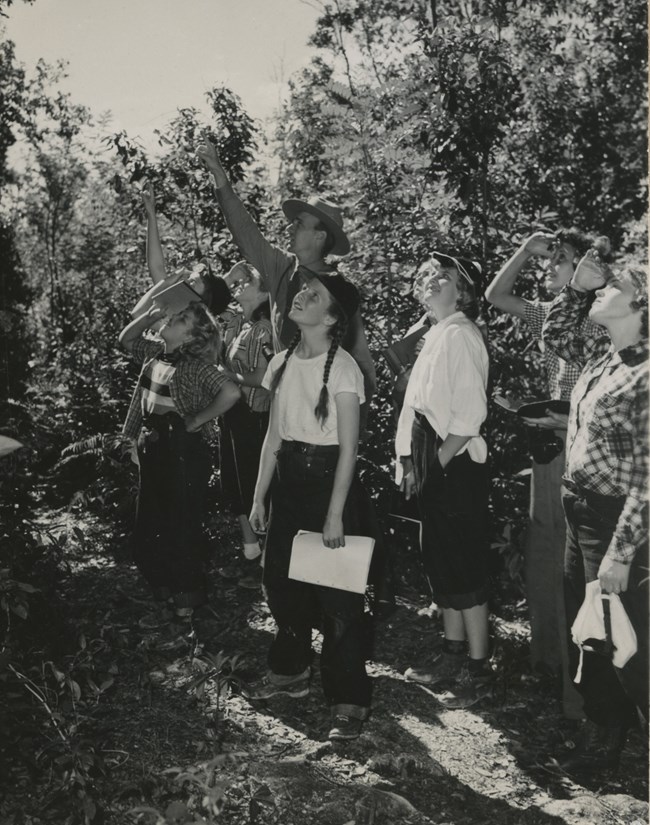
The girls wanted to learn more about the park and continue their study of native plants. The next spring new troop leader Harriet Weiss reached out to park naturalist Willard E. Dilley. Recognizing that the park didn’t have enough rangers to answer questions from visitors on busy weekends, he told Weiss, “If the girls are willing to do some hard studying, they could perform a real service here.” The girls took up his challenge and began studying in earnest. To qualify they had to identify rare birds in flight, handle snakes, and know the names of park animals and plants.
The Park Naturalist’s Monthly Report for November 1953 notes, “Plans have been made to utilize a local group of Girl Scouts to aid in giving natural history information at Anhinga Trail. No naturalist will be stationed at the site during the 1953-54 winter season. The park naturalist conducted three sessions with the Scouts familiarizing the girls with the natural history of Taylor Slough, information on the park in general, and proper deportment towards the public. They will be at their post in pairs each Saturday and Sunday from 2pm to 6pm. They are instructed that their duty is not one of law enforcement but that of being available as a source of advice and information.”
In December 1953 the first seven ranger aides—Clara Lynne Harkness, Sandra Weiss, Beth Krone, Georgiana Fry, Barbara Lucas, Annette Lewis, and Barbara Conway—debuted. They wore black arm bands embroidered with the words “ranger aide” to identify them to the public. The naturalist report for that month noted “numerous visitors commented favorably on the information courteously given by the Girl Scouts.” The ranger aides also distributed the schedule of monthly naturalist program activities to 45 locations frequented by visitors.
Two girls volunteered each weekend day. Troop members volunteered up to 20 hours every weekend throughout the winter tourist season. Subsequent monthly reports from winter 1954 also speak favorably of the work of the ranger aides. Although the troop isn’t mentioned in the reports again until December 1955, in at least the first four years of the ranger aide program, the troop never missed a weekend.
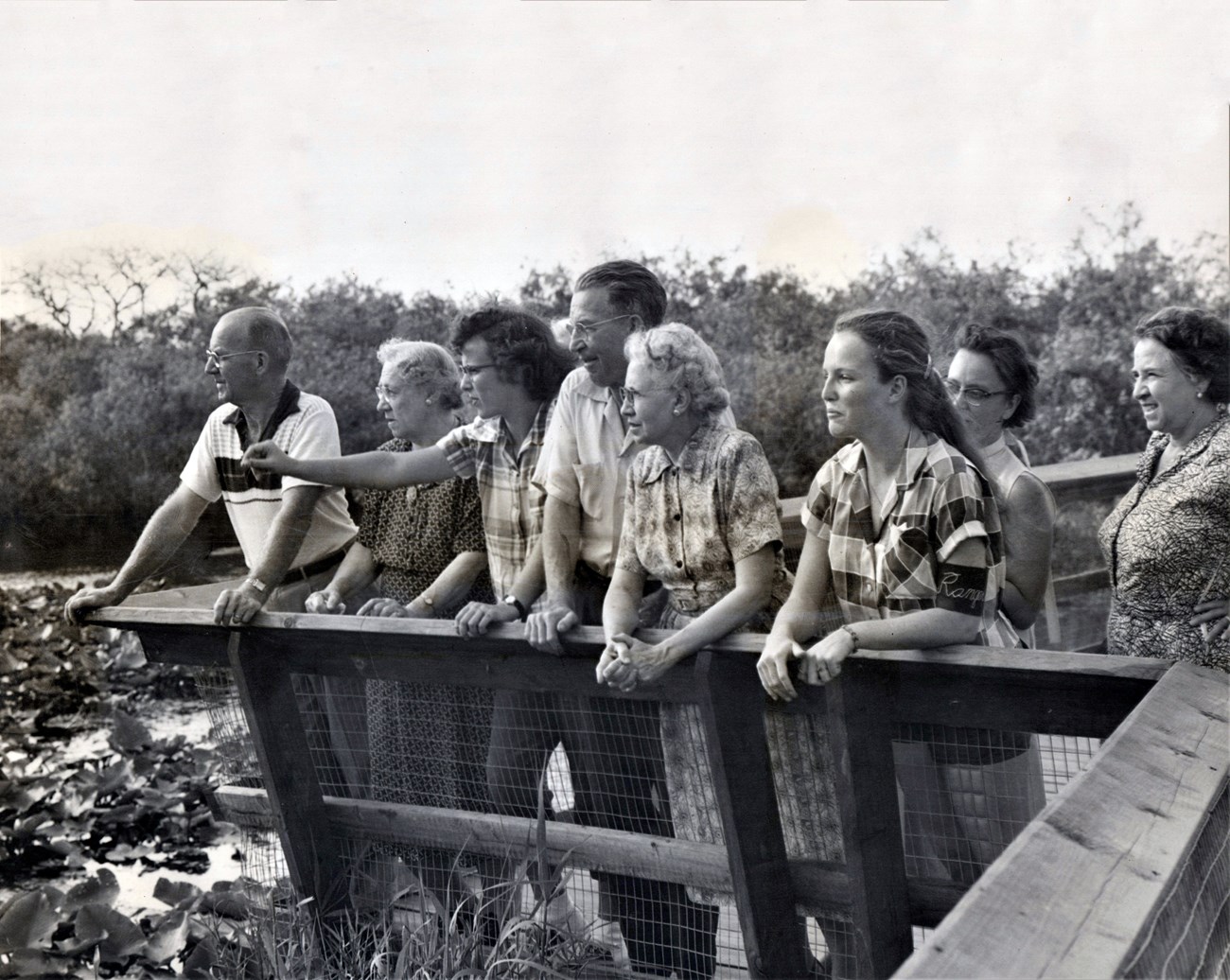
Dilley was a strong supporter of the ranger aides, even leading them on field trips in the park on his days off. When naturalists Vernon C. “Tommy” Gilbert arrived at the park in December 1954, he also helped with their training. Dilley left for Grand Canyon National Park in March 1955. His replacement, Ernst T. Christensen, continued to support the ongoing program. Although the naturalist reports often go years without mentioning them, the ranger aides continued to work in the park each winter.

The troop was a family tradition for many. Sandra Weiss was the daughter of the troop leader Harriet Weiss. Sisters Clara Lynne, Vernalida, and Tschera “Cherry” Harkness all worked as ranger aides. Clara Lynne went on to become assistant troop leader and then troop leader in the early 1960s. Sisters Pat and Nancy Hagerty were members. Daughters of NPS families were also part of the troop. Ellen and Carolyn Christensen were daughters of Chief Park Naturalist Ernst T. Christensen. Georgiana and Carolyn Fry were daughters of Assistant Superintendent George W. Fry. Darci Mendlen was the daughter of temporary park naturalists/park guides Sam and Ruth Mendlen.
When they weren’t working in the park on weekends, the ranger aides worked towards their other primary goal: an annual camping trip. Darci Mendlen Wolcott recalls, “We started each weekly meeting with the Promise, and also recited the Girl Scout laws. Then we got to work scheduling girls for weekend work at Everglades National Park. The rest of the meeting time was spent planning our summer trip.” Each girl had to earn $40 to fund the road trips. When not working at the park, these industrious girls assisted at community events and worked part-time jobs, held cake and rummage sales, and sold candy and peanuts door-to-door and fruit at roadside stands to finance camping trips to Great Smoky Mountains, Bryce, Zion, Rocky Mountain, and Grand Canyon national parks, among other places.
By 1956, there were 14 qualified ranger aides volunteering in the park. Some of those that worked in the 1950s and 1960s include Riva Peskoe, Jo Ann Baker, Carol Curtis, Janice Engelhardt, Nancy Hagerty, Linda Kirkwood, Judy McGinnis, Ronnie Melby, Minna Burrichter, Elaine Campbell, Beth Krone, Barbara Lucas, Nancy Proulx, Darci Mendlen, Anita Kloeren, Joan Dawdry, and Sue Davis. The park continued to provide training, and the ranger aides held up their end of the bargain. The December 1957 naturalist report records, “The ranger aide training program has been completed and the Girl Scouts are now meeting the visitors and dispersing information to visitors of the park."
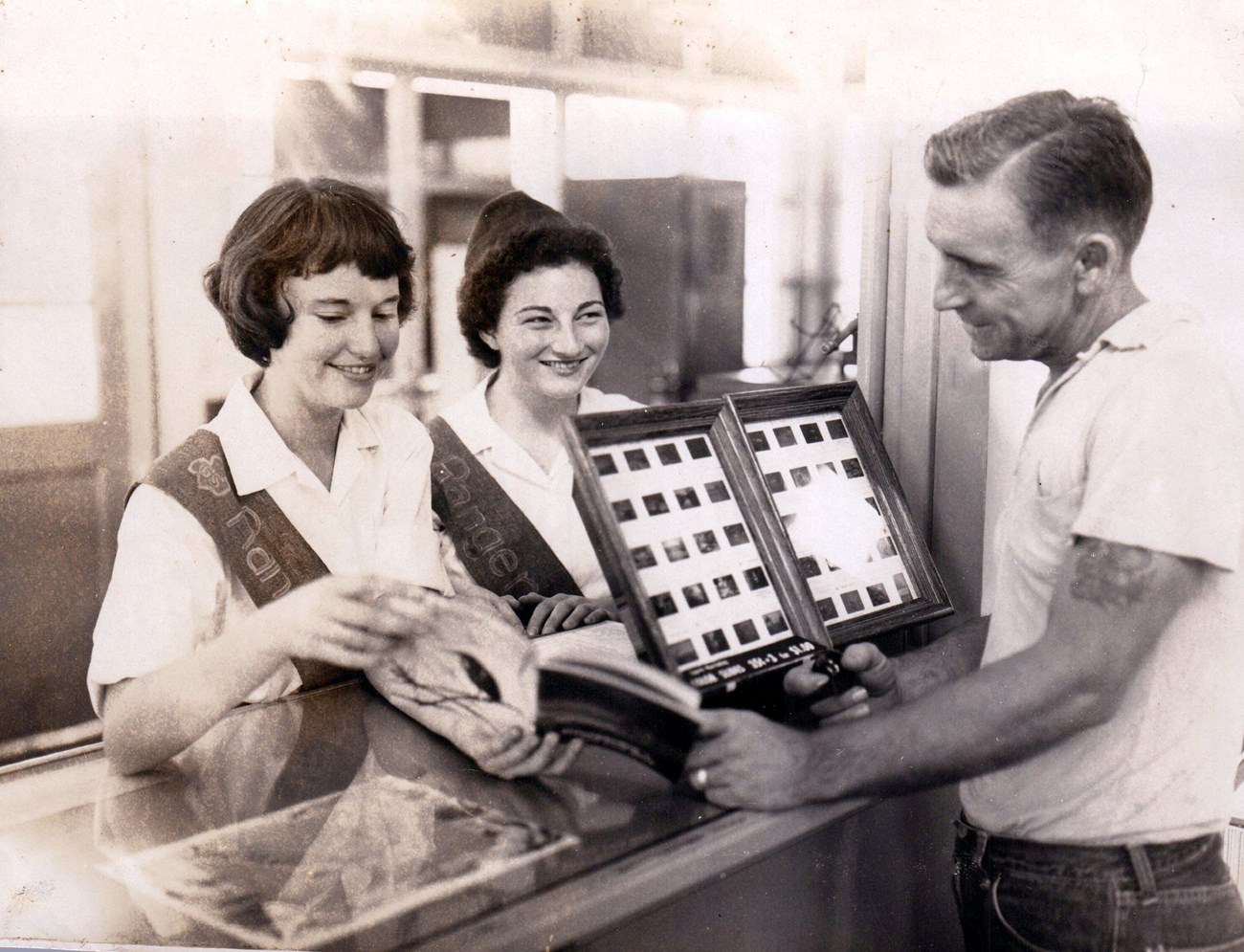
In 1964 Troop 5 had at least 18 members. Anne Erickson, Carlyle Helso, June Lawn, Marlene Mahnke, Susan Murphy, Eileen Nelson, and Terry Lynn Wolfe were all new ranger aides that year. They joined existing members Tschera “Cherry” Harkness, Susan Myrick, Sherrill Amendt, Pat Hagerty, Barbara Alspach, Cynthia McHugh, Rae Elizabeth O’Dell, Kathy Schram, Sherrie Pearson, Mary Neal, and Lorraine Mantius. They continued to be active in the community as well as the park. Their Halloween festival, for example, was attended by almost 200 children that year, helping raise funds for their service projects, camping trips, and other troop expenses.
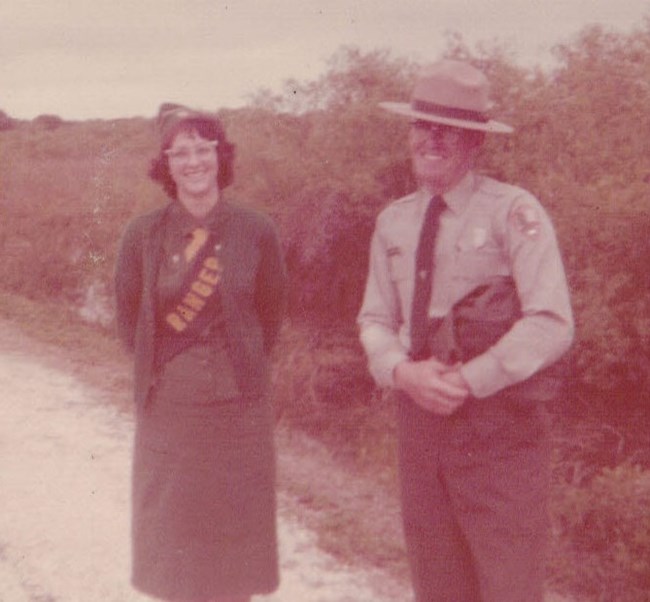
The black ranger aide arm band was replaced by at least 1956. Instead, the NPS prescribed a uniform of a white blouse, dark green trousers, belt, and Girl Scout cap. By 1960, however, they wore ranger aide sashes with the Girl Scout emblem on them. By the mid-1960s some girls wore what were probably homemade brown sashes emblazoned with “ranger aide” in yellow with their green Girl Scout uniforms. Tschera “Cherry” Harkness Connell remembers wearing the ranger aid service bar with her Girl Scout uniform. She also recalls that the ranger aides were awarded silver NPS arrowhead pins to wear on their uniforms. The pins were an optional part of the 1962 NPS women’s uniform, worn in lieu of a badge as authorized. Given that it was an official NPS uniform item until 1970, it’s not surprising that the girls were told that they could only wear them when they were on duty.
The Everglades ranger aides were featured in several newspaper columns and in articles in American Girl and Parks and Recreation magazines, but they never received any Scouting awards for their efforts. Darci Mendlen Wolcott recalls, “The local Girl Scout Council was pretty horrified with our enterprise, but I think we did try to do our duty.” Georgiana Fry Vines adds that the disapproval stemmed from the fact that “we never took time to work on badges and had our own agenda—the ranger aide program and raising money for camping trips.”
The ranger aides were still active in the park in 1969, but the program ended sometime in the early 1970s. Cherry Harkness Connell explains, “The two big draws for the troop were working in the park, and the opportunity to travel. When the troop began, many girls had never traveled at all. By the 1970s, there were many more organized activities competing for teenagers’ time. Finding girls wanting to commit to training, working regularly on weekends, and travel in the summer was becoming more difficult.”
Troop 5 is believed to be the only Girl Scout troop in the country that worked like this inside a national park. Inspired by their experiences, many went on to major in biology and related fields at college. Darci Mendlen Wolcott notes that the ranger aides developed careers in medicine, journalism, politics, library science, and education, among other fields. Several joined the Peace Corps. Most married and became mothers. Wolcott muses, “All loved the landscape and our country. I cannot speak with certainty for anyone but myself but I’ll wager that our experiences together were major influences on our characters, our relationships, and our beliefs in human potential.”
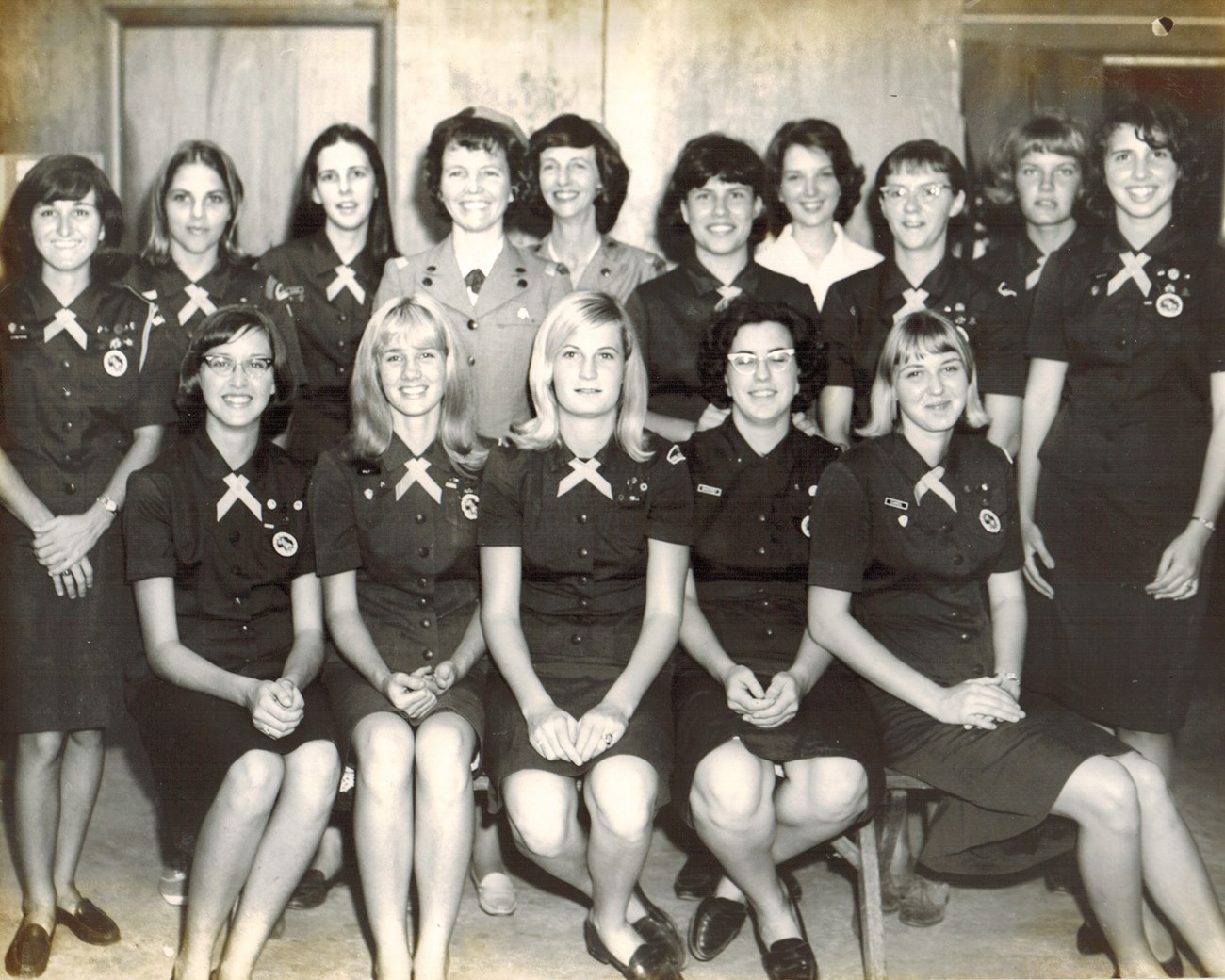
(Photo courtesy of Don and Clara Lynne Harkness Vande Hei)
Continuing the Tradition of Service
Although Everglades’ program with its decades of service was unique, other Girl Scout troops provided services to national parks to earn their ranger aide bars, which required 50 hours of natural resources service and training in outdoor living.
In 1969 and 1970, 18 girls from Troop 256 worked towards that goal at Padre Island National Seashore. Chief Naturalist Derek Hambly directed them in naturalist projects. Aged between 15 and 18 years old, the girls worked at the park on Mondays and Thursdays, counting traffic, collecting fish for ranger station aquariums, and planting vegetation on sand dunes. They also collected plants for displays with temporary ranger-naturalist Mrs. Stanley Shelton and placed bird boxes around the park. NPS staff presented programs in conservation, camping skills, and life-saving designed specifically for the troop, which included Debbie Sheller, Sharon White, Rosalind Thompson, Maureen Colvin, Sally Russell, Marilyn Gaudry, and Marion Wagner, among others.
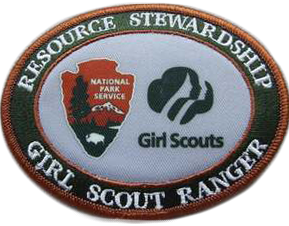
Although the ranger aide service bar was eliminated in 1979, many Girl Scout troops continued to conduct service projects at national parks. Today the NPS and the Girls Scouts of the United States of America partner to support the Girl Scout Ranger Program. The girls participate in a variety of existing organized educational or service projects at national parks or design their own experience or projects to earn program certificates and patches.
Explore More!
To learn more about the history of women and the NPS uniform, visit Dressing the Part: A Portfolio of Women's History in the NPS.
This research was made possible in part by a grant from the National Park Foundation.
